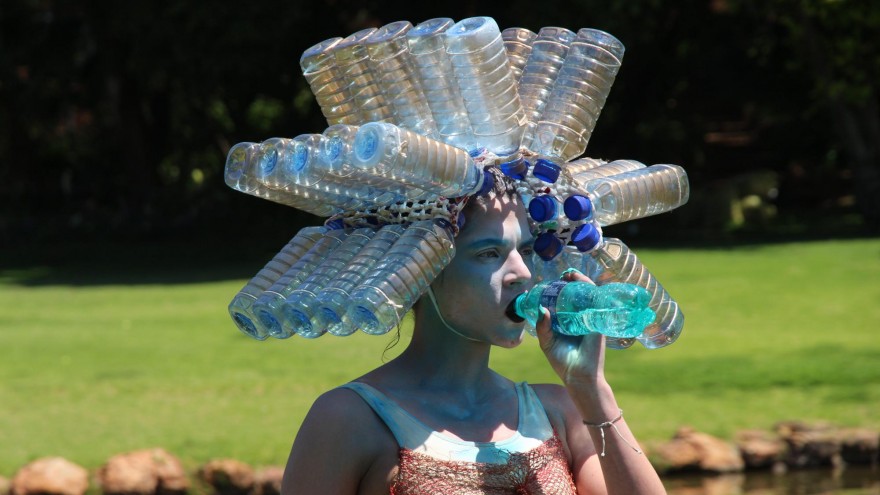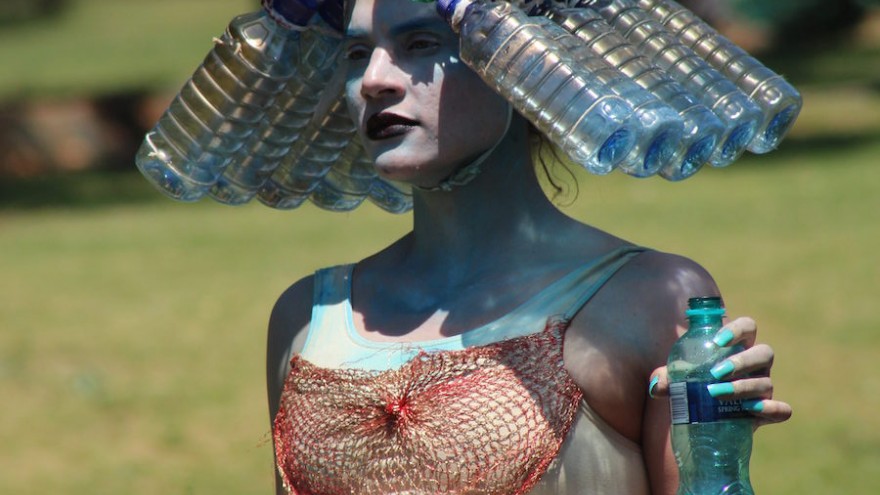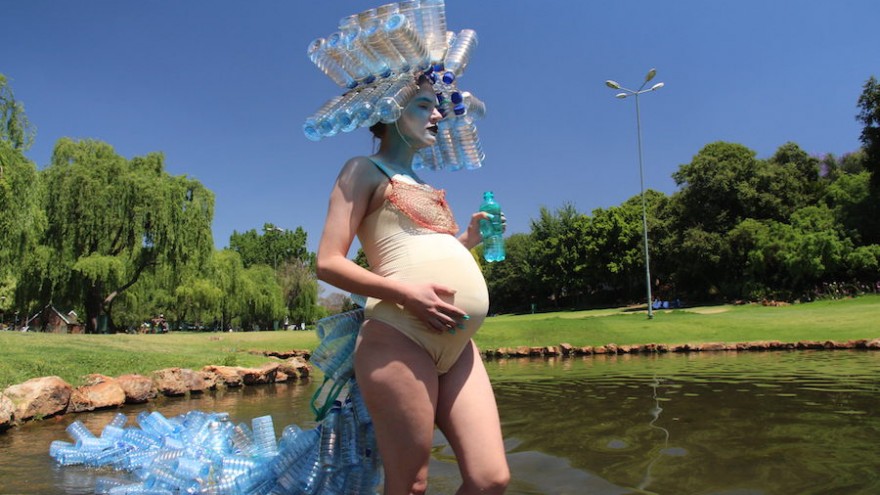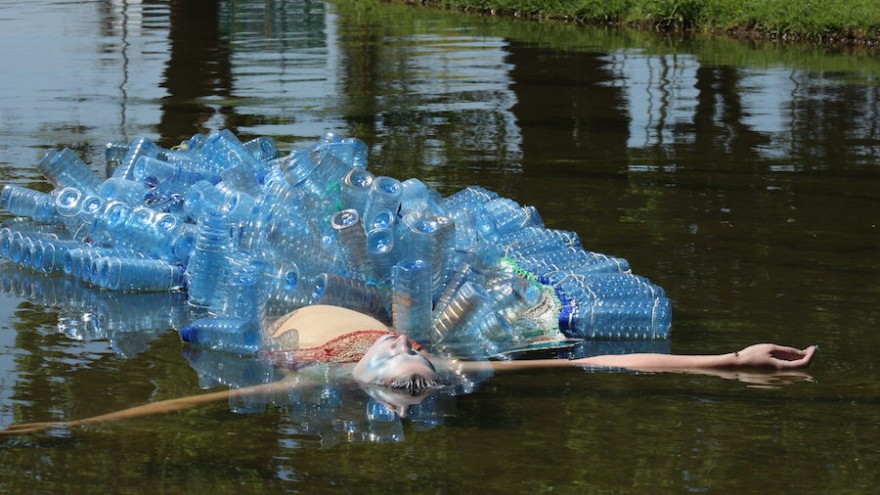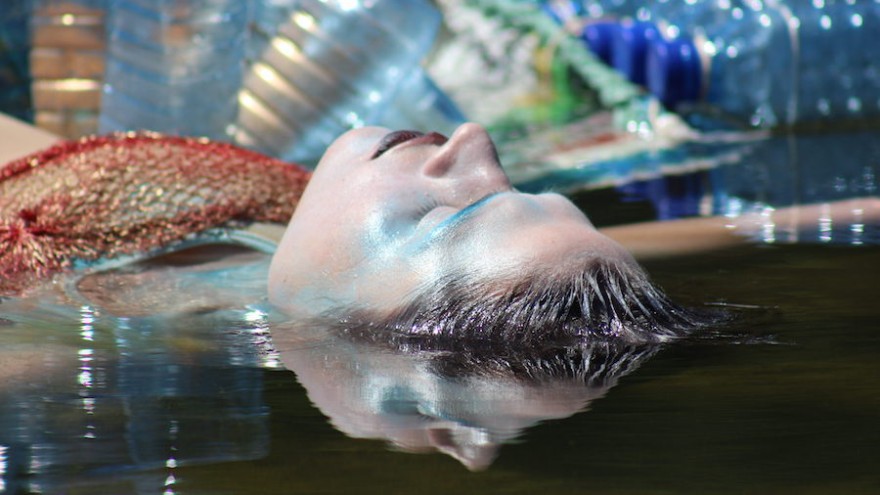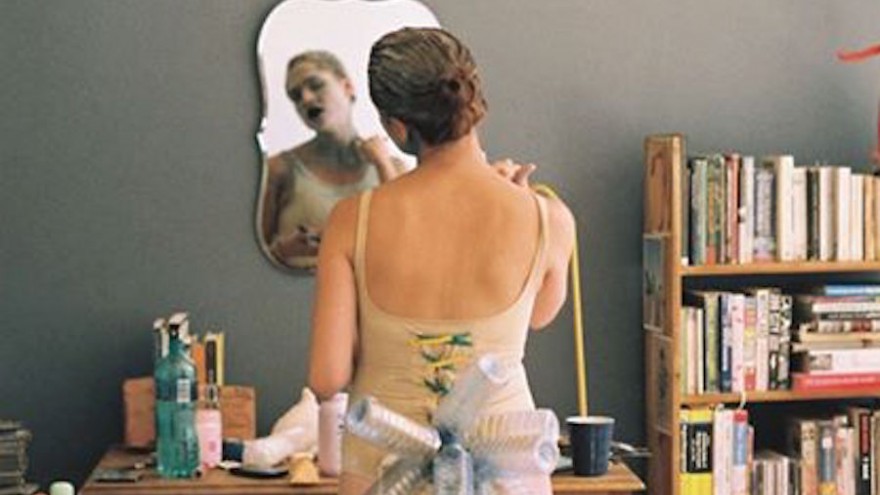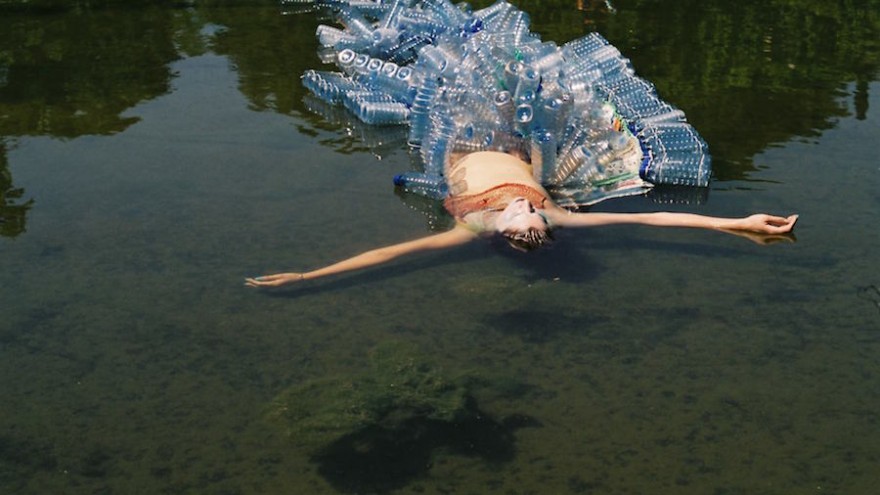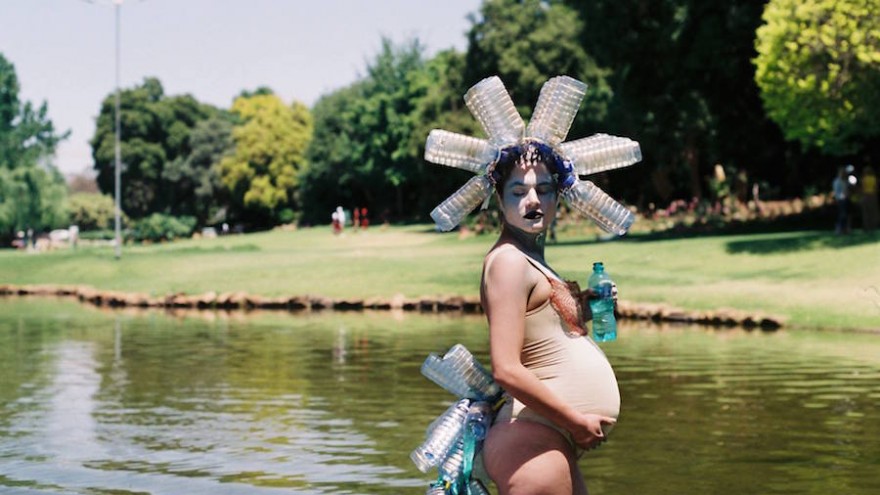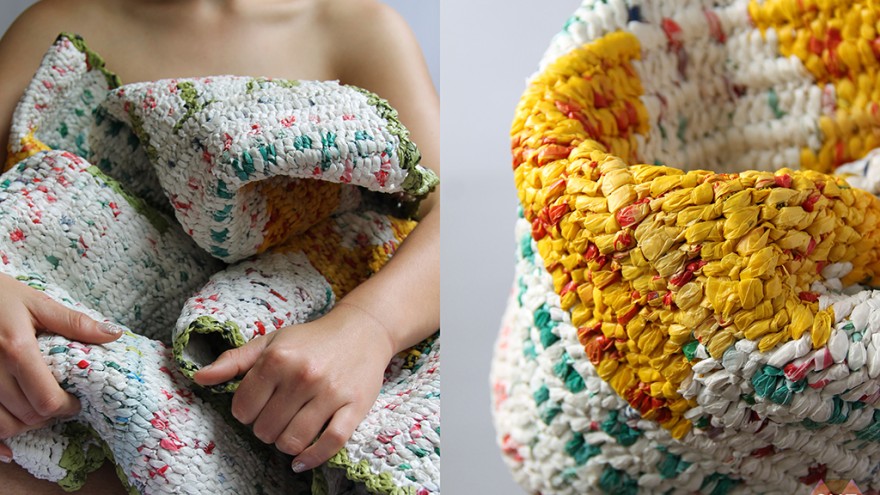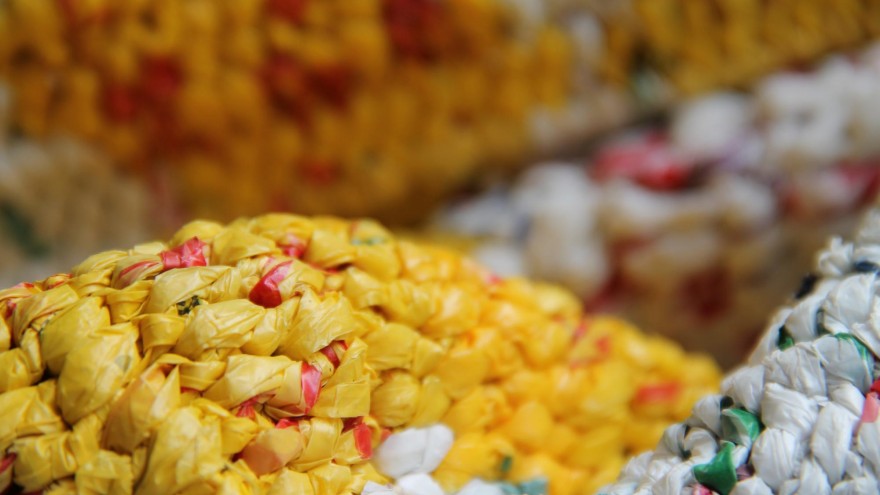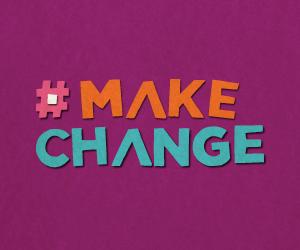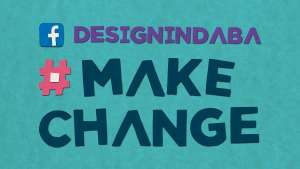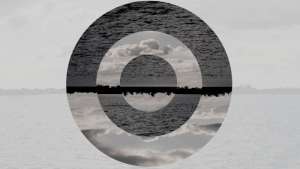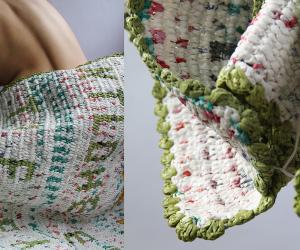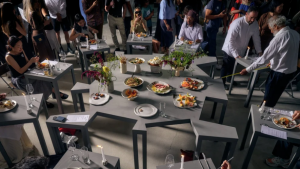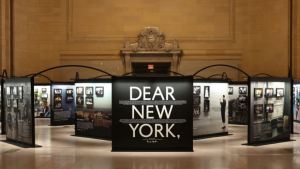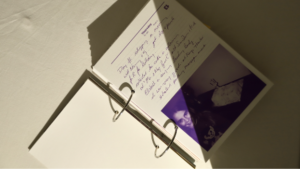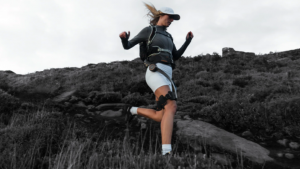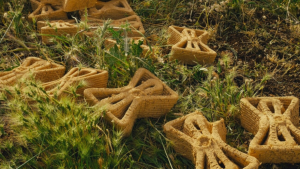Part of the Project
From the Series
Celeste Theron is a 23 year-old performance artist and fine arts student from Pretoria. Her art used to be private and individualistic but it is now more public and socially aware.
Theron is one of 40 Emerging Creatives who will exhibit their work at Design Indaba Expo 2015. Range One: Codified Crocheted Narratives is a collection of pieces woven by two women, Joanna and Nelly, with yarn made from old plastic. Plastic bags are seen as temporary things – used once and discarded – but they do not deteriorate. When woven, they make a durable, firm fabric that turns waste into art. They also enable female artisans in the SHE design collective to make a living off their craft; a good percentage of the profits is given straight to the women involved.
Range One is not the first social impact project that Theron has been involved in. Last year Celeste Theron and Ilze Wessels, a photographer friend, conceived of a project to help raise awareness for Pretoria’s polluted ground water. They aimed to build a raft made from old plastic bottles. It would be stitched together by women from the community with threads made of plastic bags found in the area, and then sailed down the Apies River on a 2km journey. The raft never sailed: Theron was eight months pregnant on the date they had planned the voyage. Instead, she performed in a robe and headdress made of bottles and floated herself on the water – until security guards chased her away.
The raft remains one of her objectives, and from the experience her collaborative project with Williams, SHE, was born.
Have you been artistic since you were young?
Yes, I took drama from a very young age up until matric and used to give my folks small performances in our living room. From grade 1 to grade 3, all I did was draw in the classroom, selling my art work to the teachers. They just left me to do my own work. In grade 3 I won my first art competition and realised that this is going to be what I do for the rest of my life.
Did your family encourage you to be creative?
Yes, they made me do ballet as soon as I could walk, encouraged me to do drama and play instruments, and didn’t allow me to watch television. I had to learn how to entertain myself creatively from a very young age. Sometimes it is difficult for them to deal with the risky performance art that I am currently doing, but they still stay supportive.
Does drama affect the way you create?
It is part of the process; every project that I do ends up being a performance art piece. Performance art allows me to internalise my concept and literally to become my work, before I distance myself from it and start with the design.
Does it affect the process or just the product?
It affects the process and the product, I suppose. I always start out doing research, internalising the research into a performance and after I can truly say that I am living and breathing my concept, I’ll start with the design.
When did you first have the desire to use your work to affect social change?
When I moved to Arcadia two years ago, I met other artists and architects that were involved in projects that instigate social change. The environment inspired me, and I realised how my work could make a difference on a larger scale. Connecting with other people that were already making change spurred me on and changed my outlook on design and art.
Have you seen anyone using design, creativity or art to make a difference that has really inspired you?
Yes: there are NGOs based in Pretoria and other organisations here that strive to support the arts in a city that has not qualified for a design capital or anything. These organisations all inspire us in that they work like a healthy family that cares for each member and sees to the personal growth of every artist.
Tell us a little bit about your water bottle raft.
The water bottle raft was a concept that evolved out of the daily urban walks Ilze Wessels and I went on to take photographs of the city. We noticed the state of the Apies River, and wanted to design an artefact that would encourage people to interact with the river and take note of the water. We decided to use materials that we’ve collected on our walks – for instance, plastic bags and water bottles – cleaning up the city as we build the raft.
Did you make that voyage?
In the end we never made the raft. I became the raft through a performance art piece in the city where we attached one thousand water bottles to a costume with plastic bags, and drifted through the water at Magnolia Dell, illustrating the effect garbage has on the living organisms in the water and the people that live next to it. Our aim is to do the voyage this year. Last year there were too many obstacles with my pregnancy.
What effect did the performance have?
I managed to do a performance for about an hour before I was chased away by security guards. Someone phoned the police. I guess people were shocked because I was eight months pregnant at the time. Interacting with water in a public park is a big taboo, but the water should be healthy enough for people not to be repulsed by it or to be too scared to come near it. It was hard for me to come to terms with how repulsive the water actually is and to swim in it with a protruding bump. My son was born a week later. I went into labour on one of our daily walks on the Lion Bridge in Arcadia, busy conducting interviews for my next project.
How has being a mother affected your approach to your art and your design work?
Being a mother has made me more focused and I work harder to achieve the goals I’ve set for myself. It has softened my outlook on life. Before I was pregnant I was devastated by the state of the world, but when I realised that I’m bringing another life into it, I wanted to change that. My son was diagnosed with Down syndrome and I wanted to make the world a friendlier place through making art and design that celebrates life and contributes to social change.
Do you work only with women with SHE?
Yes, SHE is about empowering women. I was inspired by the tale of South Africa’s Rain Queen, Modjadji, who was chased away from her kingdom when she fell pregnant with an illegitimate child. The king gave his daughter a magic horn that could make rain, in order to protect her from the angry community. Since SHE is focused around water, Modjadji became our icon.
Who are Joanna and Nelly?
Nelly Mokhondo and Joanna Kubayi are women we wouldn’t necessarily have a relationship with, but through SHE we became connected. Jonanna and Nelly are craft artisans that create products through woven plastic bags. Nelly was responsible for keeping our apartment block clean, but while she was doing it she was continuing her own work. We noticed her beautiful work and told her that she has a lot of talent. Nelly quit her job and is now self-employed creating art.
What work are you doing with them?
Ilze and I design products that Nelly and Joanna help us put together through their craftsmanship.
What do you offer them?
We are offering them a platform to launch their own creative career. We’re offering them our soft skills (research, presentation, representation) that we’ve been privileged enough to receive through our education. Nelly’s focus was more on her crafts, to use it as a medium to survive. We’ve showed her that she can do more with her skill than get by, and also rewarded her financially. Nelly and Joanna receive 40% of the sales that we make.
What can they offer you?
They offer us their skill in craftsmanship and gave us a real insight and connection in what may seem as insignificant problems in South Africa, those things that the media don’t pay attention to. By helping one woman become independent and invest in her future and the future of her children, they offer us the opportunity to get the selfish satisfaction of using our skill for the good. And that’s what we want to do.
How long will your work with them last?
It is up to them; as long as we both still have something to offer each other.
Will you collaborate with others too?
Yes.
Where did you meet Ilze?
Ilze and I met at one of my exhibitions, and through a series of events we’ve become more intertwined with each other’s lives. We both live in the same apartment block and are next door neighbours.
You are exhibiting Range One at the Design Indaba Expo this year. The items are woven out of plastic, right? Did you develop the technique yourself or did you see it somewhere?
Yes, the range is woven out of plastic. It is a traditional craft used by all women but we are not applying it in a traditional way. We are experimenting with it and want to test if it can become a structural material that could even become a regional architecture. We are studying Range One and collecting data that can be tested and studied to develop our next range and continue developing the technique of the craft itself.
What does the woven material feel like? Is it soft?
It is soft but yet firm. It has a soft crunch, almost giving a superficial material substance. Plastic is perceived as temporary but is in fact a material that does not deteriorate for twenty years. We are giving waste the position to become art.
What can it be used for?
We are using it to design urban furniture, but right now we are still testing how far this medium can be pushed. The ultimate use would be when we can effectively and creatively merge this craft with technological innovations that are happening in the upcoming century.
Do you weave words or images into your pieces?
Some pieces yes, but it is not our main intention to do so. It depends on the woman we are collaborating with.
What do the pieces communicate?
The narratives are social narratives. Instead of locating a trendy gap in the market and exploiting the artisans, we are focused on establishing the right platform for a social enterprise that can have not only an environmentally sustainable cause but also a socially sustainable one. These social narratives are what brought us here, and we want to develop them, strengthen them and let them dictate where to next.

